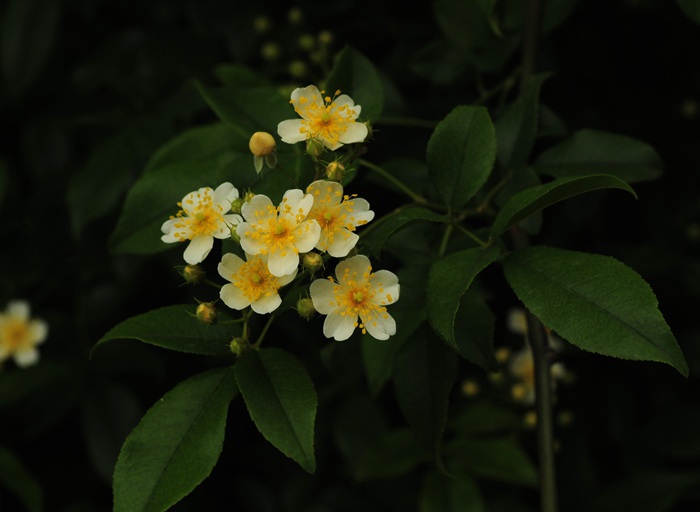- Scientific Name: Rosa cymosa Tratt.
- Ref: Ros. Monogr. 1:87. 1823
- Synonyms:
- Rosa amoyensis Hance
- R. banksiae var. microcarpa Regel
- R. bodinieri H.Lév. & Vaniot
- R. cavaleriei H.Lév.
- R. chaffanjonii H.Lév. & Vaniot
- R. cymosa f. plena Z.X.Yu & G.Z.Liu
- R. esquirolii H.Lév. & Vaniot
- R. fukienensis Metcalf
- R. patrum Lév. ex Rehd.
- R. sorbiflora Focke
- English Common Name: elderflower rose
- Chinese Common Name: 小果蔷薇 xiǎoguǒ qiángwēi
- Family: Rosaceae
- Genus: Rosa
- Distribution: Hills, open slopes, stream sides, roadsides; 200–1800 m. Anhui, Fujian, Guangdong, Guangxi, Guizhou, E Hubei, Hunan, Jiangsu, Jiangxi, S Shaanxi, Sichuan, Taiwan, Yunnan, Zhejiang [Laos, Vietnam]
- Photo: Qingliang Peak, Zhejiang
Shrubs evergreen, climbing or scandent, 2–5 m. Branchlets terete, glabrous or pubescent; prickles scattered, hooked, to 6 mm, flat, gradually tapering to a broad base. Leaves including petiole 5–10 cm; stipules caducous, free, linear, membranous, margin entire, apex acuminate; rachis and petiole glabrous or pubescent, often sparsely prickly, rarely glandular-pubescent; leaflets 3–5, rarely 7, ovate-lanceolate or elliptic, 2.5–6 × 0.8–2.5 cm, leathery, both surfaces glabrous, abaxially puberulous along midvein or both surfaces densely puberulous, midvein prominent, adaxially shiny, base subrounded, margin acutely serrulate, apex acuminate. Flowers numerous, 2–2.5 m in diam., in compound corymbs; pedicel ca. 1.5 cm, pubescent when young, glabrescent; bracts lanceolate, margin sparsely glandular-pubescent, apex acuminate. Hypanthium globose or ovoid, glabrous. Sepals 5, deciduous, ovate, abaxially subglabrous, rarely setose, adaxially sparsely white tomentose, margin often pinnately lobed, apex acuminate. Petals 5, fragrant, white or yellow, obovate, base cuneate, apex emarginate. Styles free, slightly exserted, nearly equaling stamens, densely white pubescent. Hip red, black, purple, or black-brown, globose, 4–7 mm in diam. Fl. May–Jun, fr. Jul–Nov. (Flora of China)
